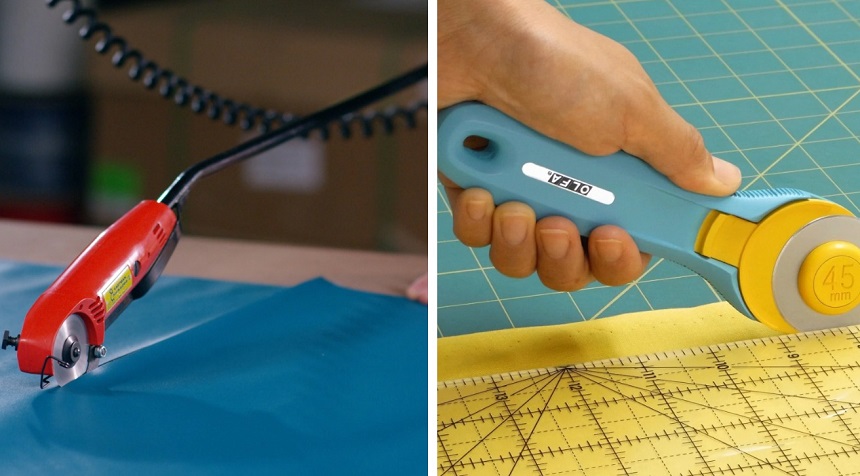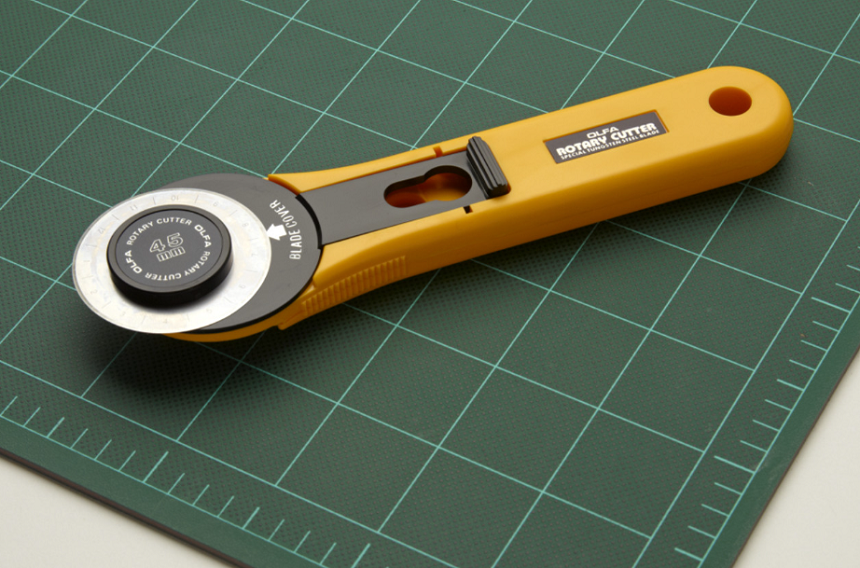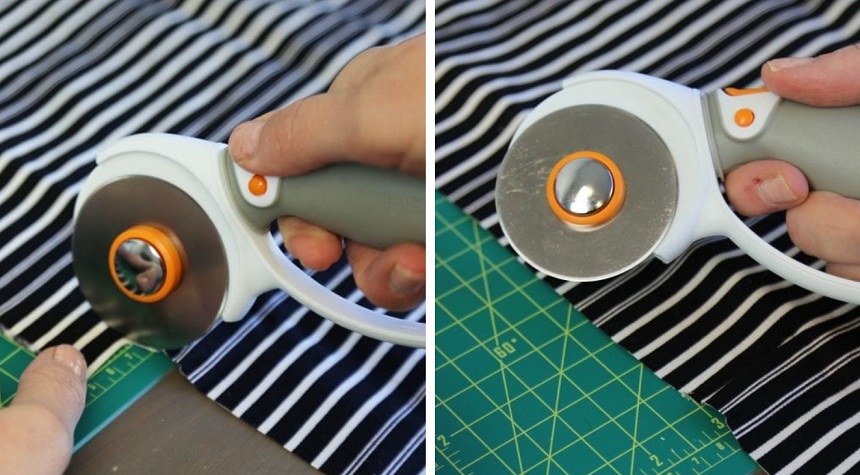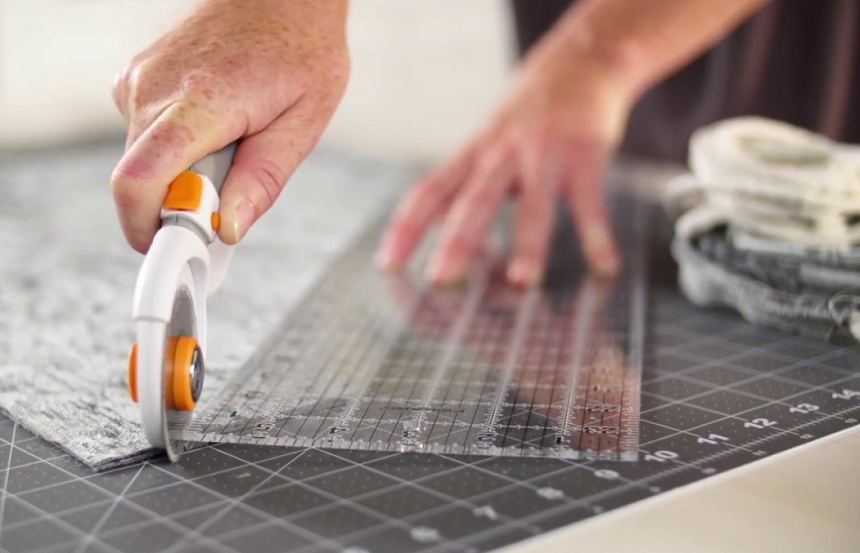Rotary cutters are one of those elite cutting instruments, especially if you’re working with fabrics, for two reasons. One is minimal hand fatigue, something you’ve likely had to deal with if you use scissors regularly. Second is their uncanny ability to cut in straight lines. To help ensure you can enjoy these perks whenever you sit down for a crafting project, we’ve compiled a list of the current best rotary cutters for fabric projects.
Our search for these products started with testing 15 of these machines, although we whittled them down to 5 of the best rotary cutters for fabric. Among our considerations was the handle, given you want something comfortable to hold. Also, there were different aspects of the blade, i.e., durability, size, and changeability. With these, you know how long the device lasts, whether it can be repaired to extend its life, and even what size fabrics it’ll work with. Keeping in mind all these features, we’ve highlighted the Fiskars Crafts Rotary Cutter, our Editor’s Choice.
The Fiskars Crafts Rotary Cutter is our Editor’s Choice for several reasons. One is the available 60mm titanium blade with the option of 45mm blades as well. The titanium coating is durable, not to mention it doesn’t lose its edge quickly. This might also explain why buyers get a lifetime warranty with the purchase. As for the size, it makes light work of thick fabrics, and you can even pick a 45 mm option if you typically deal with thinner fabrics. Lastly, the curved handle further minimizes hand fatigue even with long projects.
The Fiskars Crafts Rotary Cutter is an upgraded version of other Fiskars models like the Fiskars 195210-1001, Fiskars 01-005828, and Fiskars Comfort Loop. In addition to being larger, it accepts a larger 60mm blade which should have an easier time cutting through thicker, larger fabrics. You also get slight differences in design, with the Crafts Rotary cutter having a simpler body than its smaller counterparts which come with extra components around the blade. Lastly, the construction of the blades with the titanium coating on this option makes it more durable than the steel blades of the smaller options.
We consider the Honey’s Heaven Rotary Cutter Set the Premium Pick option due to what’s included in the package, i.e., several blades, a cutting mat, craft clips, and an acrylic ruler. Apart from the extra blades, the rest of the accessories are must-haves for anyone interested in crafting with fabrics. After all, you do need precise fabric measurements with the craft clips helping to hold your pieces of cloth in place as cut. The cutting mat also provides a self-healing surface to cut without the risk of damaging anything under the fabric.
The Honey’s Heaven Rotary Cutter Set is easily comparable to the OLFA Quick-Change Rotary Cutter that follows it on the list since they both use 45mm blades. However, if you’re new to crafting with fabrics and don’t have many tools, this cutter set is ideal due to the included accessories. If you’ve collected different accessories and tools, you may already own some of the accessories that come with this model. As such, you may be better served to get the OLFA model instead.
As for the OLFA Quick-Change Rotary Cutter, it’s this list’s best budget option. In addition to being quite affordable, it has a few other perks, including a durable tungsten steel blade and a comfortable, durable handle. The built-in blade cover may also help ensure safety if your kids make it a habit to play with your equipment. In our testing, we also noticed this option has one of the easiest quick-change blade systems for when your first blade gets too damaged to continue using.
As for the OLFA Quick-Change Rotary Cutter, comparing it with the smaller OLFA rotary cutter listed below makes sense, given they’re from the same manufacturer. Naturally, if you need something for thicker fabrics, the fact that this Quick-Change model comes with a 45mm makes it better suited for the job. If you need a rotary cutter for detail work or thin sheets of fabric or paper, 45mm blades may be overkill. However, the 28mm blade of the Olfa Rotary Cutter work just fine.
The Electric Rotary Cutter is our premium pick of the day, given it costs several times what you’ll have to cough up for the other options. That said, the cost is justified due to the electric dual-blade system, built-in sharpener, protective foot glides, etc. With both blades rotating, we noticed there’s little chance of the fabric bunching up, which helps keep the cut lines straight. Furthermore, these blades stay forever sharp, with the built-in sharpener coming in handy when they lose their edge. Also, while these blades would typically damage the worktable underneath, this option comes with the foot glides to protect it.
The Electric Rotary Cutter differs from the other rotary cutters listed, given it’s the only electric option listed. This leads to a difference in cost where you’ll have to pay significantly more for this option than other models. Additionally, it’s the only option with a dual-blade setup. You even get a unique built-in sharpener, something that’s not available with most other options. Another difference is the protective foot glides. With manual rotary cutters, you’ll have to use something like a cutting mat to protect your worktable, while this model makes do with the foot glides.
Finally, the Olfa Rotary Cutter is our best pick for detailing. The smaller 28mm blade is well suited for that kind of work, not to mention it works wonders when cutting paper and paper-thin fabrics. Despite the blade being smaller than what you get with other options, this cutter’s blade is as durable as any other, and you get the option to replace it when it eventually wears out. As for the handle, it’s less ergonomic than most others, although we felt this design helps make miniature changes to the cut when necessary.
As mentioned above, this Olfa Rotary Cutter is easily comparable to the only other rotary cutter on the list from the same manufacturer, the Olfa Quick-Change Rotary Cutter. The most obvious difference is, of course, the size of the blade, which allows for the two options to be used in different projects. There’s also the shape of the handle, which is slightly less curved than the Quick-change rotary cutter’s handle. Ultimately, if you want the best option for detailing, this Olfa Rotary Cutter will work better. On the other hand, the Olfa Quick-Change Rotary Cutter is better suited for projects that involve thick or multiple thin fabrics.
Even five options like the ones above could prove too many if you don’t know what you’re looking for. Naturally, the only way to overcome this is to educate yourself on how the various aspects affect use and ownership. That way, you end up with a rotary cutter that not only serves your needs but is affordable and lasts long. Fortunately for you, we’ve included a buying guide below so you can do just that.
Rotary cutters are cutting tools for fabric, and they come with the same basic design, i.e., a handle attached to a circular blade. It works much like a pizza cutter, although the blades are designed to work with fabrics.
While scissors work just fine for cutting fabrics, it’s easier to cut straight lines with a rotary cutter. Also, they reduce joint and hand fatigue during the cutting process.
Notably, rotary cutters aren’t the only thing you can use to make clean cuts on fabric, as fabric-cutting machines are also available. If you’re looking to automate your cutting process with machines instead, our list of the best fabric-cutting machines may come in handy.
Typically people use rotary cutters for projects that also involve sewing. As such, if you’re looking for a sewing machine to use alongside your rotary cutter, check out our best sewing machines list for great options.

Like most other tools, rotary cutters come in different variations to match different types of projects. The most basic type, as mentioned above, features a handle and a circular blade that cuts at a 90-degree angle. Other variations include electric and ergonomic, as highlighted below.
You must press the blade down with manual rotary cutters as you drag the device over the fabric. Depending on the thickness of the fabric or how many layers you’ve put together, this can be incredibly taxing.
On the other hand, electric rotary cutters do most of the work for you. For instance, you only need to press a button for the blade to rotate and start cutting. All that’s left is stabilizing the device and ensuring it cuts straight.
However, with the extra friction produced by the rotating blade, they may also require a little more maintenance than their manual counterparts.
There are also ergonomic rotary blades designed for comfort. Our Editor’s Choice, the Fiskars Crafts Rotary Cutter, is a great example with a comfortable handle that makes it easier to use for longer periods.
As for picking the best rotary cutter for fabric projects, you’d have to keep each of the considerations listed below at the top of your mind.

Rotary cutters come in different sizes, with most options being 18, 28, 45, or 60mm. Naturally, the blade size determines what kind of fabrics it can be used on and, by extension, the types of projects.
With 18 and 28-mm blades, like the one on the OLFA Rotary Cutter mentioned above, you can afford to do detail work where you’ll need to make intricate changes to the cut, e.g., with curves. The smaller blade size makes the tool more flexible.
On the other hand, 45 or 60-mm blades are better suited to cutting through multiple layers of fabric or through tougher materials like leather. With options like the 60mm blade, you can cut up to eight layers of fabric in one go.
As for the 45mm options like the Honey’s Heaven Rotary Cutter Set, they can cut through four to six layers of fabric.

In addition to the blade size, you should consider the blade type and material. Some are made of tungsten carbide steel, others are made of plain steel, while others, like the blade in the Fiskars Crafts Rotary Cutter, are coated with titanium.
Each has its advantages, with plain steel options being the most affordable. On the other hand, an option with titanium coating should be extremely durable and can hold its edge better than other alternatives.
As such, it depends on what you need. If you only want something for a quick crafts job, durability may not matter much to you. Conversely, if you’re a regular crafter, something that lasts will give you incredible service.
Ultimately, each rotary cutter is a cutting tool which means it can injure you if you’re not careful. One thing that can offset the risks of use is the inclusion of safety features, e.g., a safety lock that keeps the blade covered when the cutter is not in use.
Unfortunately, for some options, the location of the safety lock button comes with some risks. It’s positioned next to the blade, meaning you might miss it and cut yourself.
That said, safety should still be among your top considerations, especially if you let others, like your kids or spouse, use your crafting tools. After all, they may not know the dangers of the device and, as such, likely won’t be as careful during use.
You also want a rotary cutter that’s comfortable to use, especially if your crafting sessions last longer than a few minutes. Those with ergonomic handles with curved designs and rubber covers, such as our editor’s choice, are the most comfortable to use.
Other options without contouring may be harder on the hands if you hold them for too long.
As for accessories, things like cutting mats, rulers, and craft clips come in handy for any would-be crafter. If you already have them buying a rotary cutter with similar accessories may not provide much value. However, if you’re just starting and need as much equipment as possible, buying a package with other accessories is hugely beneficial.

If you use a rotary cutter on fabrics, you need a cutting mat unless you’re okay with damaging your work surface.
One of the options on the list, i.e., the Honey’s Heaven Rotary Cutter Set, even comes with the mat included. With other options, you may have to buy the accessory separately. Laying the fabric on the cutting mat also keeps it from sliding as you cut.
An acrylic ruler may also help keep the blade on track. These rulers are typically thicker than normal alternatives, keeping the blade from sliding over them. Although unnecessary, stick-on grippers can also help keep the ruler in the same position until you’re done cutting.
Next, use the safety lock to keep the blade tucked in when not in use to prevent any unfortunate accidents.
As for use cases, avoid cutting other materials, such as cardboard or paper, as they can dull the blade. For cardboard cutting, you may be better served by Cricut cutting machines as they’re built to cut through multiple types of materials. If you’re searching for one such device, our best Cricut machines list should be instrumental in finding the best fit.
Back to the rotary cutter, it’s also worth noting other hard objects can also damage the blade’s edge, so avoid them.
When cutting, ensure you apply even pressure. Standing over the fabric instead of sitting can help with this. Start from the closest point and roll the blade away from you.
Also, even with stick-on grippers, you still need to hold the ruler in place with your other hand. Ideally, you should spread your hand over it to keep it even, although it should still be far enough from the blade to protect yourself.
You can press the fabric if you need to to keep it straight. Furthermore, spray starch can help stiffen up more slippery fabrics to make them easier to cut.
You can cut multiple fabric types with a rotary cutter, ranging from cotton, linen, satin, and even thin leather.
It depends on the size of the blade. With 45mm blades, they can cut up to six layers, while larger 60mm blades can cut even more. However, try to keep the layer count minimal for more accurate cuts.
Naturally, you should limit the layer count to one or two fabrics if using a smaller blade.
Most rotary cutter blades can be sharpened. However, some manufacturers like OLFA advise against it, especially if you use their products.
Among the list of the 5 best rotary cutters for fabric, the Fiskars Crafts Rotary Cutter is our Editor’s Choice simply because it’s the most well-rounded. The large 60mm blade can handle thick or multiple layers of thin fabrics, and the handle is one of the most comfortable on the market. The fact that you can choose a smaller blade also means it caters well to most people’s needs.
The value pick, i.e., the Honey’s Heaven Rotary Cutter Set, has several perks, including an excellent design and multiple accessories. With the blade spares, you also likely won’t have to deal with searching for blade replacements for a while after purchase.
As for our budget pick, the OLFA Quick-Change Rotary Cutter also deserves its place among all the possible options above, given it offers buyers an affordable but high-quality option. The handle is also fairly comfortable.